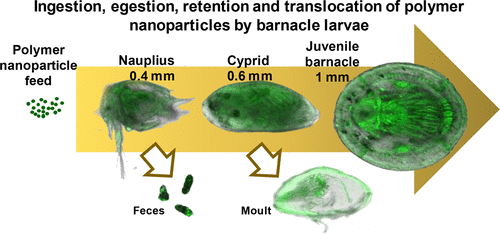当前位置:
X-MOL 学术
›
ACS Sustain. Chem. Eng.
›
论文详情
Our official English website, www.x-mol.net, welcomes your feedback! (Note: you will need to create a separate account there.)
Fate of Nanoplastics in Marine Larvae: A Case Study Using Barnacles, Amphibalanus amphitrite
ACS Sustainable Chemistry & Engineering ( IF 8.4 ) Pub Date : 2018-03-21 00:00:00 , DOI: 10.1021/acssuschemeng.8b00766 Samarth Bhargava 1 , Serina Siew Chen Lee 2 , Lynette Shu Min Ying 2 , Mei Lin Neo 2 , Serena Lay-Ming Teo 2 , Suresh Valiyaveettil 1
ACS Sustainable Chemistry & Engineering ( IF 8.4 ) Pub Date : 2018-03-21 00:00:00 , DOI: 10.1021/acssuschemeng.8b00766 Samarth Bhargava 1 , Serina Siew Chen Lee 2 , Lynette Shu Min Ying 2 , Mei Lin Neo 2 , Serena Lay-Ming Teo 2 , Suresh Valiyaveettil 1
Affiliation

|
The exposure of nanoplastics was investigated by observing their interaction with Amphibalanus amphitrite (commonly known as acorn barnacles). Poly(methyl methacrylate) (PMMA) and fluorescent perylene tetraester (PTE) dye were used to prepare highly fluorescent nanoplastic particles. At concentrations of 25 ppm, the PMMA particles showed no detrimental impact on barnacle larvae and their microalgae feed, Tetraselmis suecica and Chaetoceros muelleri. PMMA nanoplastics were ingested and translocated inside the body of the barnacle nauplii within the first 3 h of incubation. The fluorescent PMMA particles inside the transparent nauplius were tracked using confocal fluorescence microscopy. Subsequently, the nanoplastics were fed to the barnacle nauplii under two conditions—acute and chronic exposure. The results from acute exposure show that nanoplastics persist in the body throughout stages of growth and development—from nauplius to cyprid and juvenile barnacle. Some egestion of nanoplastics was observed through moulting and fecal excrement. In comparison, chronic exposure demonstrates bioaccumulation of the nanoplastics even at low concentrations of the plastics. The impacts of our study using PMMA nanoparticles exceeds current knowledge, where most studies stop at uptake and ingestion. Here we demonstrate that uptake of nanoparticles during planktonic larval stages may persist to the adult stages, indicating potential for the long-term impacts of nanoplastics on sessile invertebrate communities.
中文翻译:

Nanoplastics海洋幼虫的命运:一个案例研究使用藤壶,纹藤壶
nanoplastics的曝光,通过观察与它们的相互作用研究纹藤壶(俗称橡子藤壶)。聚(甲基丙烯酸甲酯)(PMMA)和荧光per四酯(PTE)染料用于制备高荧光纳米塑料颗粒。在浓度为25 ppm时,PMMA颗粒对藤壶幼虫及其微藻饲料,Tetraselmis suecica和Chaetoceros muelleri没有有害影响。。在孵育的前3小时内,将PMMA纳米塑料摄入并转移到藤壶无节幼体的体内。使用共聚焦荧光显微镜跟踪透明无节幼体内部的荧光PMMA颗粒。随后,在两种条件下(急性和长期暴露)将纳米塑料喂入藤壶无节幼体。急性暴露的结果表明,纳米塑料在整个生长和发育阶段(从无节幼体到塞浦路斯和幼年藤壶)都持续存在。通过换羽和粪便排泄观察到一些纳米塑料的产生。相比之下,长期暴露证明即使在低浓度的塑料下,纳米塑料也具有生物蓄积性。我们使用PMMA纳米颗粒进行的研究所产生的影响超出了当前的知识,在大多数研究中,大多数研究都停止了摄取和摄入。
更新日期:2018-03-21
中文翻译:

Nanoplastics海洋幼虫的命运:一个案例研究使用藤壶,纹藤壶
nanoplastics的曝光,通过观察与它们的相互作用研究纹藤壶(俗称橡子藤壶)。聚(甲基丙烯酸甲酯)(PMMA)和荧光per四酯(PTE)染料用于制备高荧光纳米塑料颗粒。在浓度为25 ppm时,PMMA颗粒对藤壶幼虫及其微藻饲料,Tetraselmis suecica和Chaetoceros muelleri没有有害影响。。在孵育的前3小时内,将PMMA纳米塑料摄入并转移到藤壶无节幼体的体内。使用共聚焦荧光显微镜跟踪透明无节幼体内部的荧光PMMA颗粒。随后,在两种条件下(急性和长期暴露)将纳米塑料喂入藤壶无节幼体。急性暴露的结果表明,纳米塑料在整个生长和发育阶段(从无节幼体到塞浦路斯和幼年藤壶)都持续存在。通过换羽和粪便排泄观察到一些纳米塑料的产生。相比之下,长期暴露证明即使在低浓度的塑料下,纳米塑料也具有生物蓄积性。我们使用PMMA纳米颗粒进行的研究所产生的影响超出了当前的知识,在大多数研究中,大多数研究都停止了摄取和摄入。



























 京公网安备 11010802027423号
京公网安备 11010802027423号